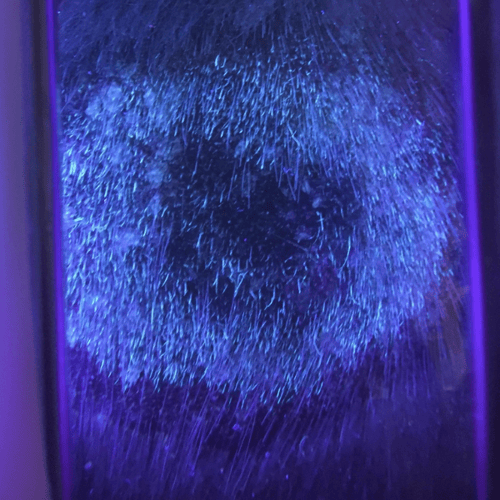- en
Ringworm sounds scary but don’t panic because there are no worms involved! It is a treatable infection that is completely manageable.
This pet information prescription will help you know what ringworm is, what to look for, how to treat it, and how to prevent this from happening in the future.
Ringworm in cats is zoonotic, which means it can pass from animals to people. Many healthy adults will not develop an infection from their infected pet, but you should limit how much you touch a pet with ringworm to reduce your risk. Children and immunocompromised individuals are at an increased risk of developing infection and of their infections taking longer to resolve with treatment. They, therefore, should not handle infected animals at all.
Most commonly, people become infected by handling an infected pet. However, you can rarely become infected by touching infected hairs and crusts in the environment, so thorough cleaning is important once an infection is identified.
Any person who develops skin lesions should seek medical attention immediately. This is especially important for children, the elderly, or anyone with a compromised immune system (i.e., people on chemotherapy), as they may suffer more discomfort from the lesions.
Quick Links

Not all 'fungi' are fun! While there are approximately 40 different species of dermatophyte fungi, the bulk of the cases of infections in cats are due to Microsporum canis (M. canis). These fungi can be fluorescent under a special UV-A light called a Wood’s lamp. (See the fluorescing photo in the What You Should Do section).
If a cat's hairs are found to glow under a Wood’s lamp, you will need other testing, like a culture or a genetic test (called a PCR test), to confirm the diagnosis.
Our mission is to help save dogs' and cats’ lives through our educational content. To support our efforts, this page may contain affiliate links. We earn a commission for qualifying purchases – at no cost to you.
Ringworm is a misleading term because a worm does not cause the infection. The actual cause is a fungus that feeds on the protein of the outer layer of hair, nails, and skin. The fungi belong to a specialized group known as dermatophytes. Therefore, the true medical term for ringworm is dermatophytosis. This common skin infection gets its nickname ‘ringworm’ because it causes a circular, red, raised rash — shaped like a ring in the people it infects.
Ringworm infections in cats look a lot different than in people. Cats usually develop patches of hair loss, crusting and flakes, small red bumps (called papules), and blackheads. They are usually not very itchy. Lesions most often occur first on the face and ears and then can spread all over the body as cats groom themselves.
Some cats, especially kittens, can be infected but not have any symptoms (they’re called asymptomatic carriers), and you may not know they’re infected until another pet or a human in your home starts to develop symptoms.
The fungus can live in your environment in infected crusts and hairs that your cat sheds, so thorough cleaning is very important after diagnosis! If there is contact with the fungus, infection does not always occur. If infection is going to occur, it is usually between 7 and 14 days after contact. Animals remain contagious until all the fungus on their bodies is dead, which will usually take 3–6 weeks with treatment but can sometimes take longer. The factors that affect whether infection occurs are the amount of contact with an infected housemate or contaminated environment, the age of the cat, as well the strength of the cat's immune system.
While some pets’ infections will resolve without treatment over time, treating your pet will clear up their infection faster and help stop it from spreading to other animals and people. It is best to use a combination of topical treatments like shampoos and sprays to remove infection from the outside of your pet’s body (in infected crusts and hairs) and oral treatments to kill the fungus at its source (in the hair follicles and deeper layers of the skin).
Ringworm is contagious. Cats usually get infections by touching an infected cat or by touching items that have touched an infected cat, such as grooming brushes, collars, carpets, furniture, and bedding. These infected items are called fomites.
The fungus on fomites can remain infectious for up to 2 years, but the good news is that it is pretty easy to kill the fungus in the environment with basic cleaning procedures.

If you suspect that your cat has ringworm, contacting your veterinarian is important. They will need to perform an exam and obtain samples for a culture to confirm your cat has ringworm.
They will also want to examine and potentially test your other pets to see if they also have ringworm. Often, at least one other pet in a household will be infected.
Using a UV-A light (Wood's lamp) the hairs of a cat infected with the M. canis fungi will glow an apple-green color. While we used to think that a lot of M. canis strains do not fluoresce, more recent analysis suggests that Wood’s lamp testing is usually positive in cats with untreated M. canis infections. However, this can be confused by the fact that some medication debris and crusting will glow a slightly different color of green. Additional testing will likely be needed.

In rare cases, if your pet has only a few small spots of infection, a topical antifungal cream or spray may be enough. However, since cats groom themselves regularly, most of the time the fungus is all over your cat even areas where their hair and skin look normal. Therefore, the majority of cats will need to be treated with oral antifungals and topical treatments Additionally, combining treatments should help your cat recover faster and reduce the risk of spreading infection to you or other family pets.
Your veterinarian will recheck your cat regularly to make sure that their infection is fully gone. They’ll check by repeating cultures of your cat’s hair and skin every 2–3 weeks. Your veterinarian will want to treat your cat until two culture plates are completely clear of fungus (called a negative culture). This usually takes about 6–9 weeks for most pets. In cats that are immunocompromised, treatment may take longer.
Make sure to follow your veterinarian’s treatment recommendations closely! To reduce your risk of picking up ringworm from your cat during treatment, wear gloves and long sleeves, and wash your hands afterward. Though it’s hard to do, it’s best to avoid snuggle time until your cat’s infection is cleared up.
The most recommended topical treatments for ringworm are lime sulfur dips and shampoos that contain both chlorhexidine and miconazole (a combination of antimicrobial and antifungal products). It is important to make sure you listen to your veterinarian’s directions carefully before starting these treatments! You need to dilute lime sulfur solution very specifically to make sure it’s safe to apply to your cat, and you need to treat at the correct frequency (usually twice weekly) to make sure topicals work as well as possible.
There are two types of oral antifungal medications (itraconazole and terbinafine), which are most commonly prescribed for cats with ringworm. Your veterinarian will decide which is best to give your cat, based on their health and size.
Shaving your entire cat is not a good idea!
It’s very stressful for kitties to be handled so much, and ringworm treatment is stressful enough! It can also spread infected hairs and crusts all over your cat and into your environment, which makes it easier for you or your other pets to get infected. However, it can be helpful to clip badly affected areas short in long-haired cats to make it easier to apply medication. Please follow your veterinarian’s advice on whether or not to cut your cat’s hair!
To help minimize spread, it is often best to confine your infected cat to a room that can easily be sanitized, has a window, and is away from any other pets, such as a bathroom or less used space with hard floors (no carpet!). Cats are kept in quarantine for potentially 2 to 3 months.
The reason you isolate your cat is to keep infected fur and crusting from spreading all over your home, protecting yourself and any other pets. Limit any bedding, toys, or food and water bowls in this area to things that can be washed daily.
However, keeping a cat isolated from their human and animal family members is very stressful for them and can make it harder for them to integrate into your family if they are new arrivals. Young kittens especially require a lot of socialization to learn how to positively interact with their people and environment, so isolating them for long periods can be bad for their long-term health and happiness. Please take your veterinarian’s advice about whether isolating your cat is a good idea, and if so, provide plenty of play and enrichment to keep them active and engaged, and continue their socialization while isolated. Always follow all your veterinarian’s treatment instructions to make sure that your cat only needs to be isolated for as short a time as possible!
Behavior and socialization resources:
What to Do If Your Cat Is Bored
Kitten and Adult Cat Socialization
How to Mimic Hunting to Improve Your Cat's Play Sessions
If you are quarantining your infected cat, you will need to make sure you clean your entire home after their quarantine starts and also that you clean their quarantine area daily to make sure they don’t reinfect themselves! Wear gloves, long sleeves, long pants, and close-toed shoes while cleaning, and wash your hands and clothes afterward to reduce the risk of contamination.
The best news about ringworm is that the fungus in your home can be killed pretty easily with normal cleaning products! Any time you are using sprays or other products with strong smells for cleaning, please keep your pets away from the area until they are dry to avoid causing irritation.
You will need to clean anywhere your infected pet has been thoroughly at least twice weekly, with cleaning to remove pet hair and debris daily. Anything that cannot be completely cleaned, such as cat trees, fabric cat toys, or soft-sided pet carriers, should be thrown away — they can re-infect your cat for up to 2 years!
Any washable fabric items (such as bedding, clothes, and towels) should be washed twice at any temperature on the longest wash cycle to kill fungal spores. After washing and drying, spray your washer and dryer inside with appropriately diluted chlorine bleach (1 pint of bleach in 1 gallon of water) or accelerated hydrogen peroxide cleaners and let them dry to kill any remaining spores.
To clean any carpets or rugs, you will need to first vacuum to remove any hairs or crusts. Then, you will want to wash carpets twice using a carpet shampooer (they’re often available for rent at hardware stores) and allow the area to dry.
To clean hard flooring, first remove hair and crusts using wipes or vacuuming. You can then wash with wood oil soap for hardwood floors or use dilute bleach or accelerated hydrogen peroxide cleaners to kill any remaining infection.
Dishes, combs, plastic toys, and other non-porous items can be cleaned with a regular dish soap detergent until clean to kill any fungus on their surfaces.
Remember to wear gloves, long sleeves, and long pants while cleaning and wash your hands when done. Be sure to change your clothes and wash them as soon as you finish sanitizing or handling your cat.
You will usually start to see improvement after about 2 to 3 weeks of treatment.
The fur will begin to grow back and there will be less crusting and redness. Many cats’ recheck cultures will be negative after 3 weeks of treatment, though it can take up to 6 weeks or longer for some cats.
Even if your cat is improving, make sure you keep treating it until your veterinarian says you can stop. If you stop treatment too soon, the infection can come roaring back and no one wants that!
If your cat continues to get more lesions and has continued hair loss beyond the first two weeks of treatment, contact your veterinarian.
It may be necessary to add or change medications or increase your cat’s treatment frequency. Additionally, your cat’s veterinarian may need to perform more diagnostic tests to ensure that no other health issues are affecting your cat’s immune system.

The best way to prevent ringworm from re-infecting your cat is to thoroughly decontaminate their environment during and after treatment and to limit their contact with other cats outside their household.
Clean and disinfect all surfaces and items in your home and throw away anything that can’t be completely cleaned. See instructions for this in the Environmental Sanitation section above.
Limit your cat’s contact with other cats outside the family by keeping them indoors and making sure your veterinarian thoroughly examines any new furry family members before they come in contact with your cat.
Cats that go outside can be bathed once or twice weekly with an antifungal shampoo recommended by your veterinarian to keep them clean and remove any bacteria or fungus from their bodies.
Luckily, ringworm infections are very treatable, but it’s a lot of work, so you don’t want to have to do this more than once!
The Pet InfoRx® is made possible, in part, through our partnership with AlignCare®.


© Preventive Vet. All rights reserved. PreventiveVet.com
